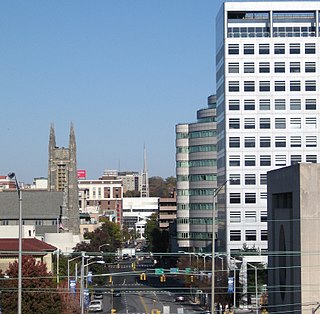
Fairfield County is a county in the southwestern corner of the U.S. state of Connecticut. It is the most populous county in the state and was also its fastest-growing from 2010 to 2020. As of the 2020 census, the county's population was 957,419, representing 26.6% of Connecticut's overall population. The closest to the center of the New York metropolitan area, the county contains four of the state's top 7 largest cities—Bridgeport (1st), Stamford (2nd), Norwalk (6th), and Danbury (7th)—whose combined population of 433,368 is nearly half the county's total population.

Trumbull is a town located in Fairfield County, Connecticut, United States. The town is part of the Greater Bridgeport Planning Region, and borders on the cities of Bridgeport and Shelton, as well as the towns of Stratford, Fairfield, Easton and Monroe. The population was 36,827 during the 2020 census. Trumbull was the home of the Golden Hill Paugussett Indian Nation for thousands of years before the English settlement was made in 1639. The town was named after Jonathan Trumbull (1710–1785), a merchant, patriot and statesman, at its incorporation in 1797. Aviation pioneer Igor Sikorsky lived in Trumbull during his active years when he designed, built, and flew fixed-wing aircraft and put the helicopter into mass production for the first time.

The Merritt Parkway is a controlled-access parkway in Fairfield County, Connecticut, with a small section at the northern end in New Haven County. Designed for Connecticut's Gold Coast, the parkway is known for its scenic layout, its uniquely styled signage, and the architecturally elaborate overpasses along the route. As one of the first, oldest parkways in the United States, it is designated as a National Scenic Byway and is also listed in the National Register of Historic Places. Signed as part of Route 15, it runs from the New York state line in Greenwich, where it serves to continue the Hutchinson River Parkway, to Exit 54 in Milford, where the Wilbur Cross Parkway begins. Facing bitter opposition, the project took six years to build in three different sections, with the Connecticut Department of Transportation constantly requiring additional funding due to the area's high property value. The parkway was named for U.S. Congressman Schuyler Merritt. In 2010, the National Trust for Historic Preservation called the Merritt Parkway one of "America's 11 Most Endangered Historic Places".

This is intended to be a complete list of the properties and districts on the National Register of Historic Places in Fairfield County, Connecticut, United States. The locations of National Register properties and districts for which the latitude and longitude coordinates are included below may be seen in an online map.
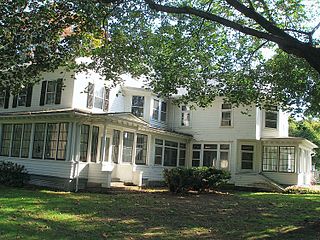
Boothe Memorial Park and Museum sits on a 32-acre (130,000 m2) site in the Putney section of Stratford, Connecticut. Built about 1840 and remodeled in 1914, it is said to be "The Oldest Homestead in America," since it sits on the foundations of a 1663 house, and has been continuously occupied. Circa 1914 two brothers, David Beach Boothe and Stephen Nichols Boothe, created the Boothe Memorial Museum which maintains a collection of twenty architecturally unique buildings. Some of the structures include a carriage house, Americana Museum, miniature lighthouse, windmill, a clock tower museum, trolley station, chapel, and a blacksmith shop. The property became a public park owned by the town of Stratford in 1949.

Penfield Reef Lighthouse is a lighthouse in Connecticut, United States, on Penfield Reef at the south side of Black Rock Harbor entrance on the Long Island Sound, off the coast of Fairfield, Connecticut. Constructed in 1874, it was one of the last offshore masonry lights. Most offshore lights built after this were cast iron towers built on cylindrical cast iron foundations.
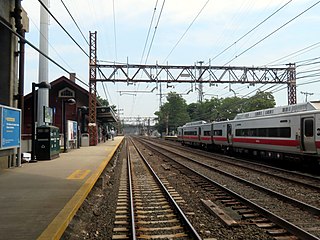
Cos Cob station is a commuter rail station on the Metro-North Railroad's New Haven Line, located in the Cos Cob district of Greenwich, Connecticut.
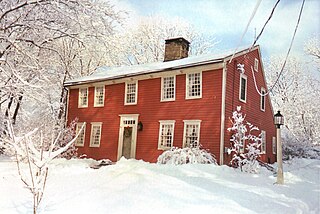
The Ephraim Hawley House is a privately owned Colonial American wooden post-and-beam timber-frame saltbox house situated on the Farm Highway, Route 108, on the south side of Mischa Hill, in Nichols, a village located within the town of Trumbull, Connecticut, the U.S. It was expanded to its present shape by three additions. Over time, the location of the house has been identified in four different named townships, as jurisdictional boundaries changed, but it has never been moved. These towns were Stratford (1670–1725), Unity (1725–1744), North Stratford (1744–1797), and Trumbull (1797–present).

Nichols, a historic village in southeastern Trumbull in Fairfield County, Connecticut, is named after the family who maintained a large farm in its center for almost 300 years. The Nichols Farms Historic District, which encompasses part of the village, is listed on the National Register of Historic Places. Originally home to the Golden Hill Paugussett Indian Nation, the area was colonized by the English during the Great Migration of the 1630s as a part of the coastal settlement of Stratford. The construction of the Merritt Parkway through the village, and the subsequent closing of stores and factories, turned the village into a bedroom community in 1939. Aviation pioneer Igor Sikorsky lived in three separate homes in Nichols during his active years between 1928 and 1951, when he designed, built and flew fixed-wing aircraft and put the helicopter into mass production for the first time.
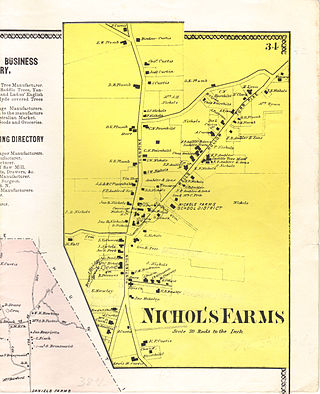
Nichols Farms is a historic area within the town of Trumbull, Connecticut. The Nichols Farms Historic District, which encompasses part of the area, is listed on the National Register of Historic Places.

The Riverside Avenue Bridge is the only cast-iron bridge in Connecticut and one of a small number still in use in the United States. It carries Riverside Avenue over the New Haven Line railroad tracks in the Riverside section of Greenwich, Connecticut. The bridge was part of an earlier span built in 1871 over the Housatonic River by the New York and New Haven Railroad, and when that bridge was replaced, part of it was erected in Riverside in 1895. It was placed on the National Register of Historic Places in 1977.
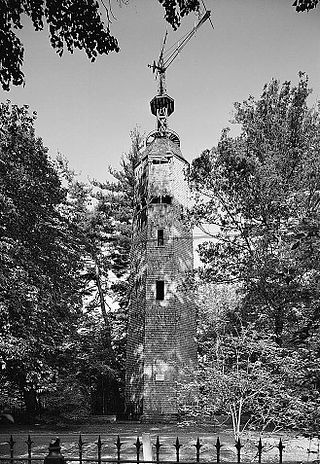
The Bronson Windmill is an historic windmill at 3015 Bronson Road in Fairfield, Connecticut. Built in 1893-94, it is the only surviving windmill in the town, ouf a number that once dotted the landscape. It was built for Frederic Bronson, owner of the local estate. The mill was listed on the National Register of Historic Places in 1971.

The Washington Bridge, also known as the Devon Bridge, carries U.S. Route 1 (US 1) over the Housatonic River in the U.S. state of Connecticut, connecting the city of Milford to the town of Stratford. Its geographic location is N 41.20037 by W −73.11039. It is considered architecturally notable by the National Register of Historic Places for its five 100-foot-long (30 m) arches. It is designated Bridge No. 327 by the state Department of Transportation.

Trumbull, a town in Fairfield County, Connecticut, in the New England region of the United States, was originally home to the Golden Hill Paugussett Indian Nation, and was colonized by the English during the Great Migration of the 1630s as a part of the coastal settlement of Stratford.

The John Knap House, also known as Samuel Knap House, is a historic house at 984 Stillwater Road in Stamford, Connecticut. The house is a 2+1⁄2-story wood-frame structure, five bays wide, with a large central chimney. It was built c. 1705 by a Capt. John Knap and was owned by his son, Lt. John Knap. The house was bought from the Lt. John Knap's estate by his son Samuel Knap in 1765. It is believed to be the second oldest house in Stamford.

The Pequonnock River is a 16.7-mile-long (26.9 km) waterway in eastern Fairfield County, Connecticut. Its watershed is located in five communities, with the majority of it located within Monroe, Trumbull, and Bridgeport. The river has a penchant for flooding, particularly in spring since the removal of a retention dam in Trumbull in the 1950s. There seems to be a sharp difference of opinion among historians as to just what the Indian word Pequonnock signifies. Some insist it meant cleared field or open ground; others are sure it meant broken ground; while a third group is certain it meant place of slaughter or place of destruction.
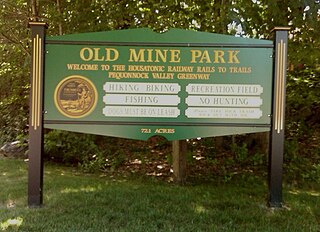
The Old Mine Park Archaeological Site is a historic site in the Long Hill section of Trumbull, Connecticut, United States. It was mined from 1828 to 1920 and during 1942-1946, and has been incorporated in a municipal park. It was added to the National Register of Historic Places in 1990.

The War Office, also once known as the Capt. Joseph Trumble Store and Office, is a historic commercial building on the Lebanon Green in Lebanon, Connecticut, built about 1732 as a commercial building. It is most significant as the place from which Governor Jonathan Trumbull conducted military business during the American Revolutionary War. It is now part of the museum property managed by the Connecticut Society of the Sons of the American Revolution that also includes the Trumbull House and the Wadsworth Stables. The building was listed on the National Register of Historic Places in 1970.

The David Mallett Jr. House, also known as The Mallett House, is a historical site located at 420 Tashua Road in Trumbull, Connecticut. It lies directly across Tashua Road from the Christ Episcopal Church and Tashua Burial Ground. The site consists of a 1.5-acre (6,100 m2) property and two buildings. The residence measures 3,196 square feet (296.9 m2), was constructed in 1760, and is privately owned. It was added to the National Register of Historic Places in 1986.
This is a list of the properties and historic districts in Stamford, Connecticut that are listed on the National Register of Historic Places. The locations of National Register properties and districts for which the latitude and longitude coordinates are included below, may be seen in an online map.






















